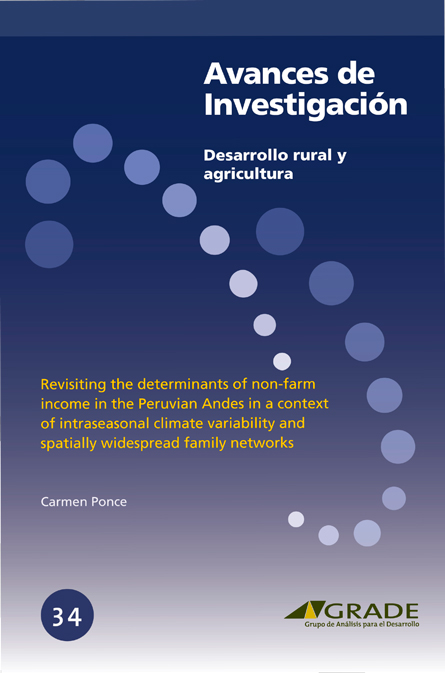Revisiting the determinants of non-farm income in the Peruvian Andes in a context of intraseasonal climate variability and spatially widespread family networks
| Year | : | 2018 |
|---|---|---|
| Author/s | : | Carmen Ponce |
| Area/s | : | Rural development and agriculture |
Ponce, C. (2018). Revisiting the determinants of non-farm income in the Peruvian Andes in a context of intraseasonal climate variability and spatially widespread family networks. Lima: GRADE. Avance de Investigación, 34
Non-farm income sources are increasingly important in the developing world, representing up to 50 percent of average rural household income. Although there is a vast literature on the determinants of rural households’ strategies for income diversification, two factors associated with long-term transformations and common to many developing countries, have not yet been integrated into the analysis: (i) the role of intraseasonal climate variability (affected by climate change), and (ii) the role of family networks located in distant areas (increasingly important given population displacement due to the internal conflict and increasing connectivity via roads and communications). Whereas an increase in climate variability entails an increase in risk and vulnerability for farm activities, family networks located in distant regions(that do not share the local climate or market shocks) may become a key asset for managing risk and fostering income opportunities (as long as they convey information and opportunities that are not available through local networks). Given the market imperfections that are common in developing rural areas—especially those related to climate risk management—explicit consideration of both factors is key to understanding rural households’ diversification strategies. The study aims to contribute to this pending agenda, investigating the role of these two factors on a household’s income diversification into non-farm activities in the Peruvian Andes, a mountain region with large intraseasonal climate variability and limited but increasing spatial connectivity, where the rural population was severely affected by the internal conflict that took place in the country during the eighties and nineties.
Two economic outcomes are modeled: the share of non-farm working hours and the share of non-farm labor income. We find that controlling for other assets and environmental conditions, households with distant but strong networks tend to diversify more into non-farm activities (the results suggest that there is a substitution effect between distant strong and weak ties). Increases in intraseasonal climate variability (proxied by temperature range during the main crop growing season) induce rural households to increase the relative share of nonfarm income and working hours. The analysis shows heterogeneous effects within the Andean region. While in the Northern region and colder areas in the Central Andean region (below 13˚C during the crop growing season) an increase in intraseasonal climate variability induces rural households to increase non-farm income-generating activities, the Southern region shows no significant impact. Further
analysis is needed to understand whether this lack of effect is explained by farm-related responses.
These results suggest that interventions focused on helping farmers cope with climate change should consider not only farm activities but skills and assets required to access non-farm occupations as well. A type of asset that is usually neglected by development projects is households’ distant networks, which can actually play a role in risk management strategies, according to our results.






